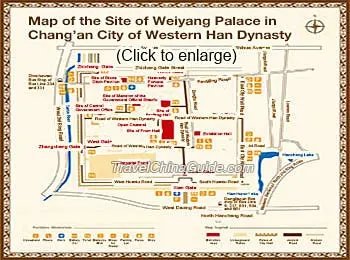The Site of Weiyang Palace in Chang’an City of Western Han Dynasty
Weiyang Palace History
Wiyang Palace was first built in 200 BC. After Han Dynasty perished, it still functioned as the political center of seven further dynasties. Moreover, the great diplomat Zhang Qian set off for other countries from the front of the palace, and developed the great Silk Road. The palace fell into disuse during the Tang Dynasty (618-907) because new palaces in which the emperors would reside and work were constructed. As time went by, the great palace fell into disrepair as it lost its importance.
The Weiyang Palace had been the administrative center of many dynasties. It was square in shape, with a main gate on each side of the palace wall. The North Gate and East Gate had exquisite watchtowers. Vassals used to enter the palace through the East Gate, while government officials through the North Gate. The two other gates were rarely used. There were also some minor gates for the transport of daily necessities to the palace. The palace occupied 4.84 square kilometres, about seven times the size of the Forbidden City in Beijing. It was divided into three parts by two avenues which ran from east to west. It is recorded that the palace consisted of over 40 major buildings, including the Front Hall, the Heavenly Fortune Pavilion, and the Jiaofang Hall.
Today's Site of Weiyang Palace
 |
| Map of Weiyang Palace Site (Click to enlarge) |
The Site of Weiyang Palace in Chang'an City of Western Han Dynasty was included in the World Heritage Site as the starting point of Silk Road On June 22nd, 2014. Since then, many historical relics have been excavated from the site and the construction of a museum is under way. Since Weiyang Palace reconstruction is not in the plan, all the buildings you see today are historical sites. They are mainly the foundations made of rammed earth.
The site, located northwest of Hancheng Lake Park in Xi'an, measures 7,054 feet (2,150 meters) from east to west, and extends 7,382 feet (2,250 meters) from south to north. The exhibition area covers a total area of 6.11 square kilometres. Major historical sites include the Site of the Front Hall, the Site of the Jiaofang Hall, the site of Central Government Office, and Mansion of Government Official Shaofu, and Southwest Turret. Also, there is an exhibition hall of the relics of Chang'an City of the Han Dynasty.
A great number of historical relics have been found, including inscribed wooden slips, bone slips used for divination or drawing lots, and exquisite eave tiles. Moreover, many articles of daily use have been found, such as ceramic bows, basins, and trays. What is astonishing is that the iron crossbows are engraved with their serial numbers and places of production. In order to show the structure of ancient roads, palace walls, city walls, and drainage system, many ways of exhibition are employed, such as original exhibition, virtual display, and showcases. For example, stones of different colors are used to simulate buildings. Black stones mark out the inside of houses, yellow stones represent walls, and white ones are courtyards. It is very vivid and interesting.
How to get to the Site of Weiyang Palace
2. Take bus 223, 713, or 912, get off at Gaobaozi Station, and walk east for about 700 meters.
3. Take bus 226, get off at Yanquemen Village, then walk east for about 700 meters.
Xi'an Bus / Metro Search
| Ticket Price | Free of charge |
|---|---|
| Opening Hours | All day long |